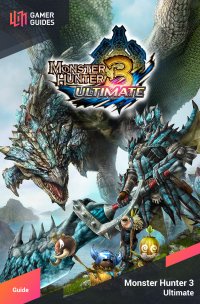Be Prepared to Learn¶
Be ready to take a few knocks before you’re a master Hunter.
Monster Hunter is a game that requires you to play to its rhythm, and that requires you to be ready to accept that and learn what it wants from you. Weapons swing in very specific ways. Monsters behave in unique, erratic fashions. Items don’t work instantly and can’t be used without fore-thought.
Be prepared to learn, to store information and to adapt to how Monster Hunter plays. Accept this, and getting ‘in’ to Monster Hunter will be much easier.
Take Time to Yourself¶
The Moga Woods are a fantastic environment to practice without fear of mucking up a quest.
It’s all well and good that you’ll want to dive in to slay massive monsters, perhaps alongside friends, but it’s recommended that you take some time to yourself in Moga Woods before anything else.
Swing your weapon around, get used to its heft. Move around a monster. Harvest some Herbs, Blue Mushrooms and Honey so you can make yourself a pile of potions. Five minutes to iron out personal creases can save hours of humiliation amongst friends.
Prepare¶
Get it in your head that you need to eat meals - forgetting only hurts you.
Never just charge out on a quest, always take time to buy supplies from the store and eat a meal from the Feylne cook. Taking an extra handful of potions doesn’t make you any less of a hunter, it makes you better prepared for the trials ahead.
With time you’ll learn to keep a stash of Pitfall and Shock Traps, Tranquillizer Bombs, Flash Bombs and other such materials so you can go on quests fully stocked up. Two minutes of careful prep can save tens of minutes - and potential failure - in combat.
Observe¶
Drooling and limping are key signs that a monster is on their last legs.
Tackling a monster is not a simple case of slapping its face until it falls over. Creatures in Monster Hunter show signs of weakness that you need to observe and adapt to. Dribbling chops and panting shows a lack of stamina; a good time to attack or lay a Stun Trap.
Steaming heads, ragged breaths and red eyes are often signs of heightened aggression, signalling to you that you should switch to careful defense. Limping is the common signal that a monster is injured and that combat is nearing its end. Keep your eyes open at all times.
Run!¶
It’s not cowardly, honest.
Laying the aggression on a monster is all well and good but you need to be prepared to run, and learn how to move away from a monster.
Some weapons allow speedy movement even when drawn, such as the Sword and shield or Dual Blades, but others, the Great Sword in particular, require you to sheath and un-sheath as you fight to ensure optimal movement is maintained.
During an encounter it’s often best to attack cautiously; land a few hits and then move out the way. Understanding this, and working out how to move with your chosen armament, will go a long way to ensuring more successful hunts than failures.






 Sign up
Sign up

No Comments